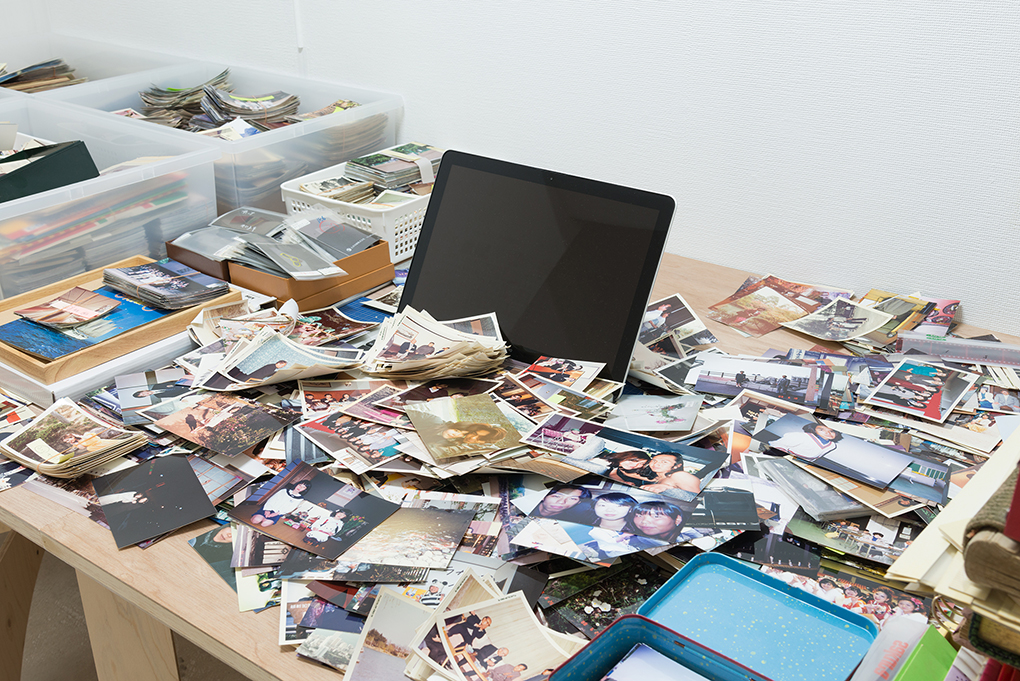
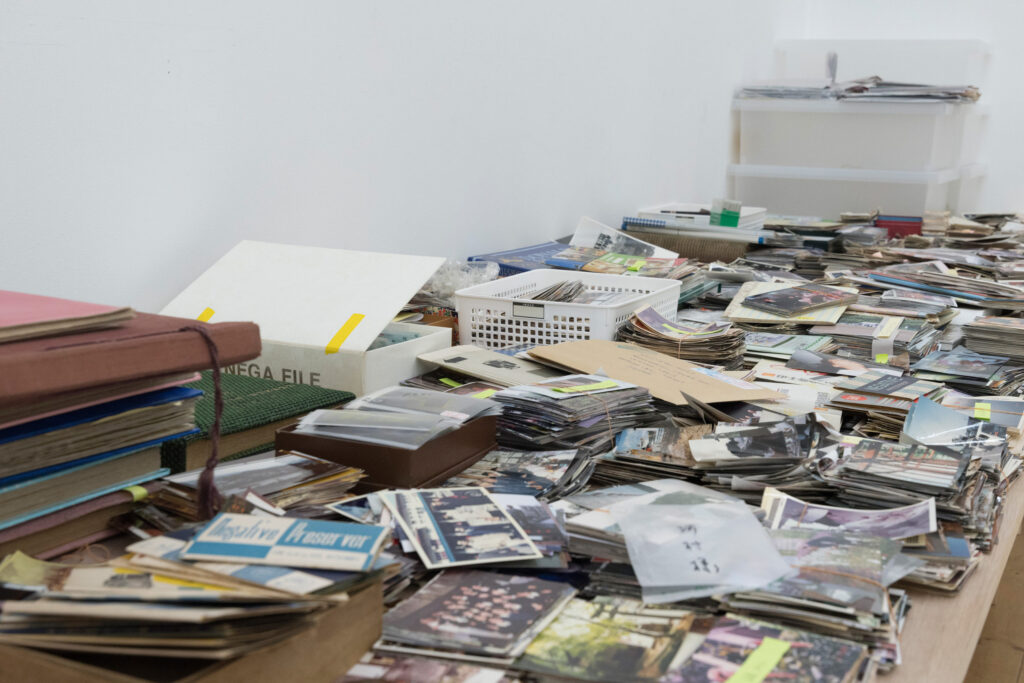
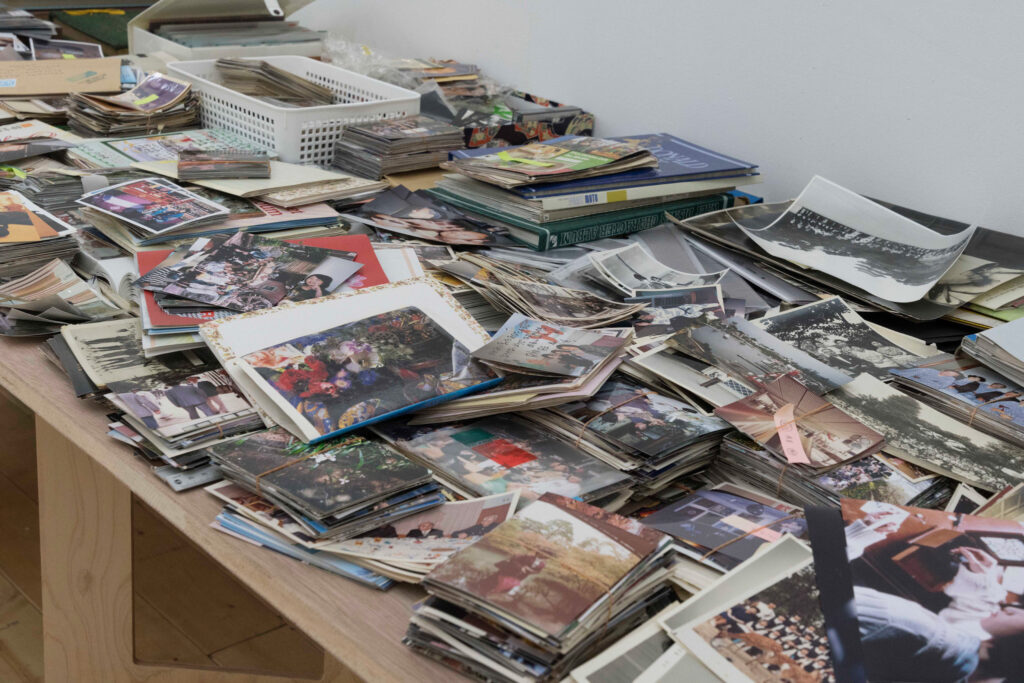
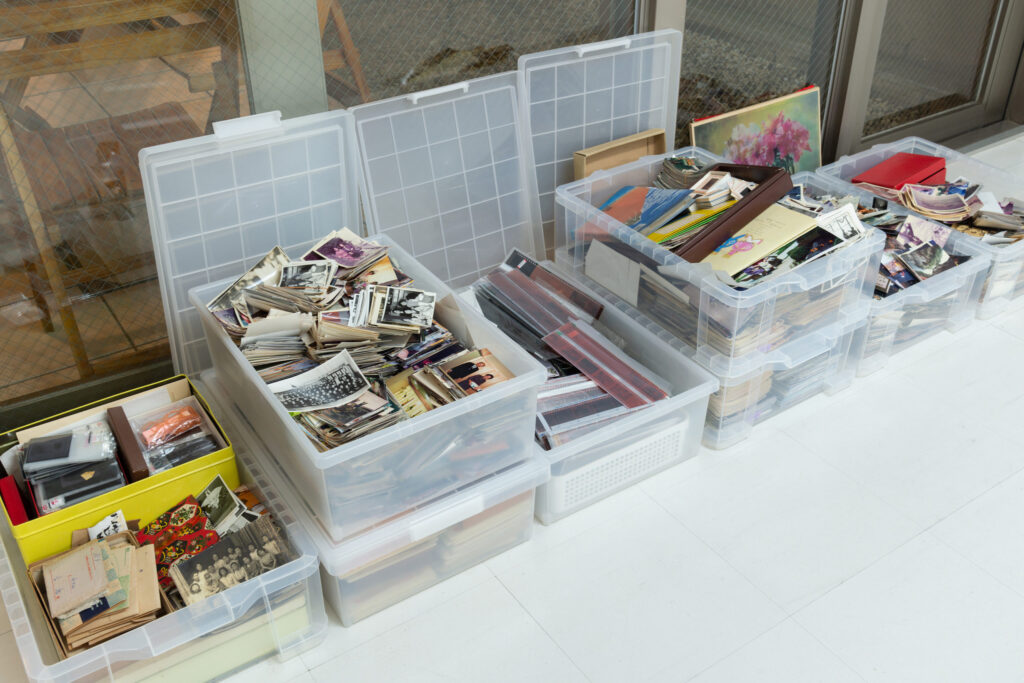
A Mountain of Images
2017–Current
photographs, albums and others
Most of the photographs collected here are “photos that should have been thrown away.” The initial reason I started collecting photos was that I heard that a large number of photos were among the garbage collected daily by industrial waste disposal companies, and that there was no one to pick them up and throw them away.
Through interviewing the disposal companies, I found out that the garbage was sorted into “sellable” and “unsellable” piles, with the former being put on the market and the latter being thrown away. I was given permission to keep the photos that were to be discarded. In the beginning, each photograph was neatly divided into sachets, sorted, numbered, and stored. However as the number of cooperating companies increased, so did the numbers of photographs we received, and the task reached its limits.
One of the things that happened as a result was a transformation of my physical being. Because of the history of their retrieval, these photographs are thought to capture many of the deceased. Among them, those born in the 20th century and recently deceased are a rare generation in which physical images have been preserved for almost the entire period between birth and death. As I pondered all of their lives through photography, their existence was burned into my mind, and I have come to dream of these strangers.
Incidentally, in the context of art vernacular, there is a technique known as “found photography.” In this method, a photograph that is originally taken for a “non-artistic” purpose (perhaps documentary or archival purposes), is “re-discovered” by an artist and “reborn” as art. The context of the photograph is rewritten to change the way the photograph is viewed. As a result, the photograph may gain artistic value, but at the cost of losing the intensity of human presence; so intense it may burn itself into the mind of the viewer.
These piles of photographs, then, exist somewhere between art and non-art, telling the stories of people who existed at one point in time in Japanese history.
写真の山
2017年–現在
写真、アルバム、その他
ここに集められている写真のほとんどは「捨てられるはずだった写真」である。写真を回収し始めたきっかけは、不用品回収業者や産廃業者らによって日々回収されているゴミの中におびただしい数の写真が含まれており、引き取り手もなく捨てられているという話を聞いたことだった。
その実情を確かめるべく業者を取材してみたところ、実際にはゴミとして捨てられているものの中から「売れるもの」と「売れないもの」とに選別されており、前者は市場に出され、後者は廃棄されていることがわかった。そこで、許可を得て捨てられる写真を預かることになった。
そうして、一度は廃棄されるはずだった写真を回収した当初は、一枚一枚をきちんと小袋に分け、分類し、ナンバリングを施し管理していた。しかし、協力してくれる業者が増え、引き取る写真の量が増えていくにしたがって、作業は限界を迎えるようになった。
その結果起きたことのひとつは、自らの身体の変容である。
これらの写真は、その回収の経緯から、多くの故人の姿を収めていると考えられている。その中でも20世紀に生まれて近年亡くなった人々は、生まれてから亡くなるまでのほぼ全年代にわたって物理的なイメージがのこされることになった稀有な世代である。そうした人々の全イメージを、写真を通じて追体験しているうちに、その人の存在が脳裏に焼き付き、知らない人が夢に出るようになった。
ところで、アートの文脈で「ファウンド・フォト(発見された写真)」と呼ばれている手法がある。これは、芸術以外の目的で撮影された写真を芸術的な観点から「発見」し、それが置かれる文脈を書き換えることによって、写真の見え方を変えてしまうという手法である。その結果「芸術作品」という視座は得られるかもしれないが、その代償に、第三者の内面に焼き付いてまでこの世に残存してしまう人間の存在感は失われてしまうことだろう。
しかし、この写真の山はそれとは反対に、ある時代の日本で生きた人間の存在感を今に伝えている作品未満の何かなのである。
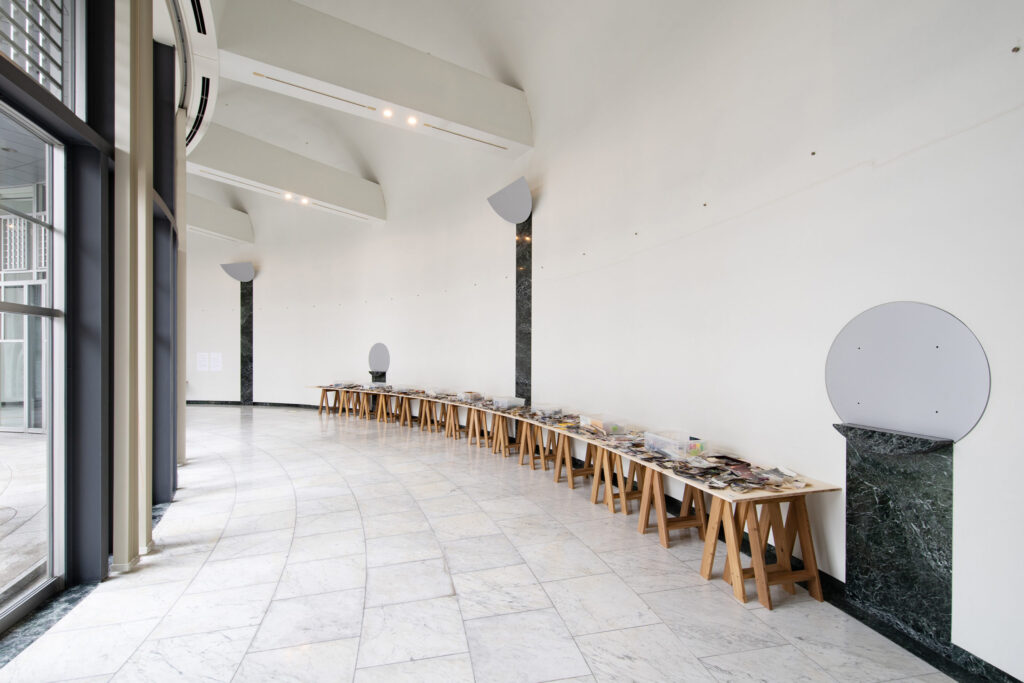
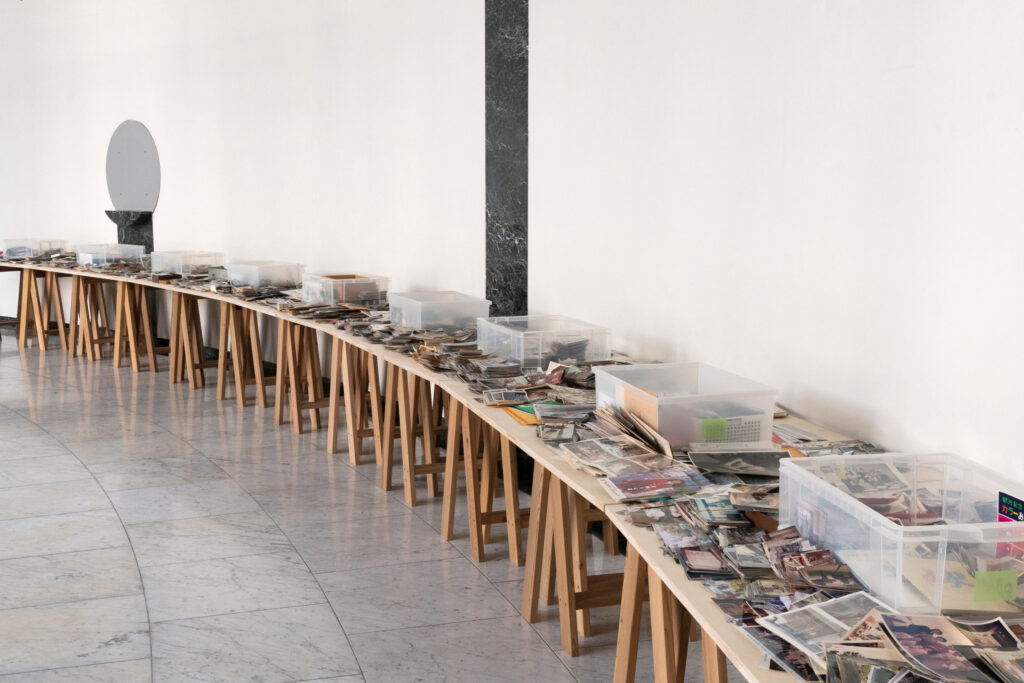
Photo: Hanada Kenichi
The Story of How the Photographs Came to be Stacked into a Mountain
Yuki Harada
At some point, I started experiencing muscle pain because of the photographs. I rented a room on the fifth floor of an old building as a storage cum studio, but there was no elevator in the building, so I had to go back and forth between the first floor and the fifth floor many times. I’ve been doing this for the past few years; climbing up and down stairs with boxes full of photos, and every time I do, my muscles ache. I don’t think many people realize, but photographs are actually quite heavy.
I started collecting photos after hearing that trash collected daily by garbage collectors and waste disposal companies contained innumerable photographs that were unclaimed and thrown away without a place to go. When I interviewed the garbage collectors to confirm the situation, we found that the photographs were sorted into “sellable photos” and “unsellable photos” on the spot, and that the former was sold at flea markets and on the Internet, while the latter was thrown into the incinerator.
What intrigued me was that many of the workers I met during the interviews were minorities. Mr. E, who is from Cameroon, I became especially close to, and we started to keep in touch on a private basis. The more I learned about his working life, the more I found out that these photos were being accumulated daily in the “periphery” of society. It seemed to overlap with the “peripheral” existence of these men and women who were collecting the photos in Japanese society. Regardless of their being family portraits or photos for sale, what these photographs have in common is that they are definitely “missing” something. In the field of contemporary art, it is not uncommon for artists to manipulate the context of an unclaimed photo to reclaim it as a work of art. Now, looking at these photos, I don’t think there’s anything more audaciously brazen than this act of reclaiming. I came to this conclusion on my first visit to a warehouse of a certain waste collector and witnessed a scene that shocked me.
A worker in a van led me to a warehouse that looked like an ordinary house from the outside. But once inside, I witnessed large piles of junk that had been collected by different vendors filling up every inch of space. Being that we were inside a ‘minka’ (a traditional Japanese house made of wood), it looked like an abandoned hoarder’s garbage mansion. In one corner, there was a pile of photographs stacked high and sitting mound-like. The piles of photographs, void of familial love and banished from capitalist society, looked like a cursed monument embodying the discontents of society.
To reveal the existence of these photographs to the world, I sought to make these images public in the form of an exhibition.
The image below, on the other hand, is an illustration from the March 2020 issue of Kohkoku (Vol. 414) titled One Million Seeings. It is based on the twenty-four-hour video work of the same name. From the video, where unclaimed photos are “just looked at,” fifty-two still images were selected and displayed over 104 pages throughout the magazine, with newly photographed images for the front and back inserts. The new photos depict the piles of photographs I saw at the warehouse; unmanned shots that were taken in the morning and night using a timer.
For me, photography is like a trauma that you can’t forget no matter how hard you try. Earlier, I called the pile of photographs I found at the warehouse “a cursed monument.” Encountering this monument, I instinctively felt its foreboding aura as if it was wrong to touch it and as if its very existence was taboo which made me reconsider reclaiming these condemned photographs and shining a spotlight on it. Even so, I could not ignore my urge to bring these images into the light for some reason. At one point, I started dreaming of the strangers I observed in the photos. I think these photographs (= images) are something that resurrects no matter how many times they are discarded.
Is it possible to form a work, maintaining a precarious position, where a viewer is not compelled to contextualize the images within their own inner world but rather to think about the lives and essence of the individuals in the photographs?
(Translated by Sonia Hasegawa-Bruinooge)
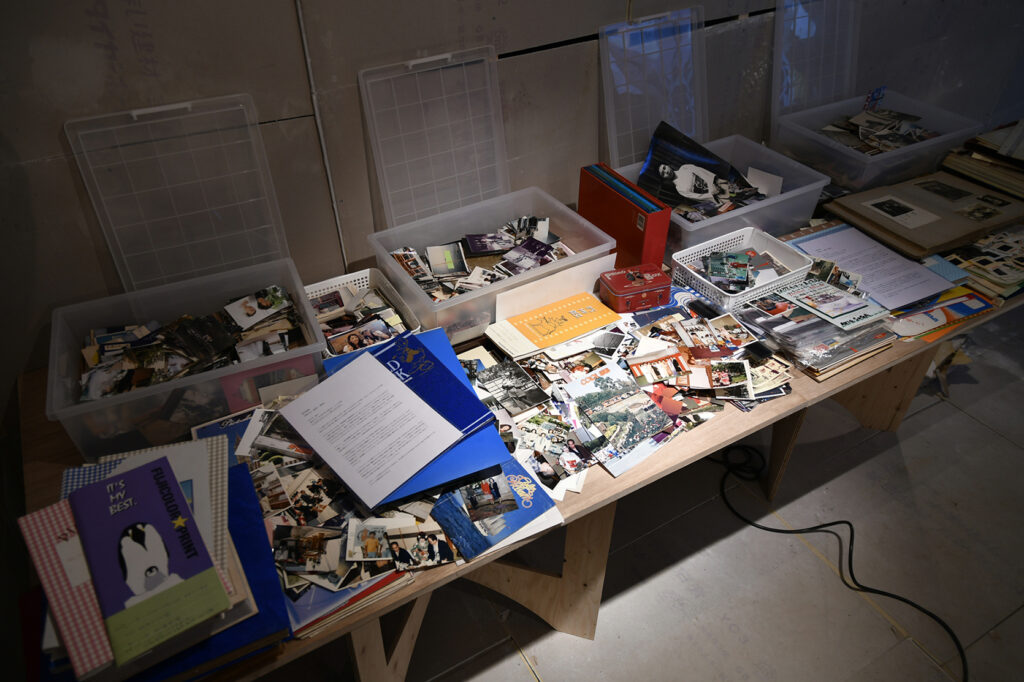
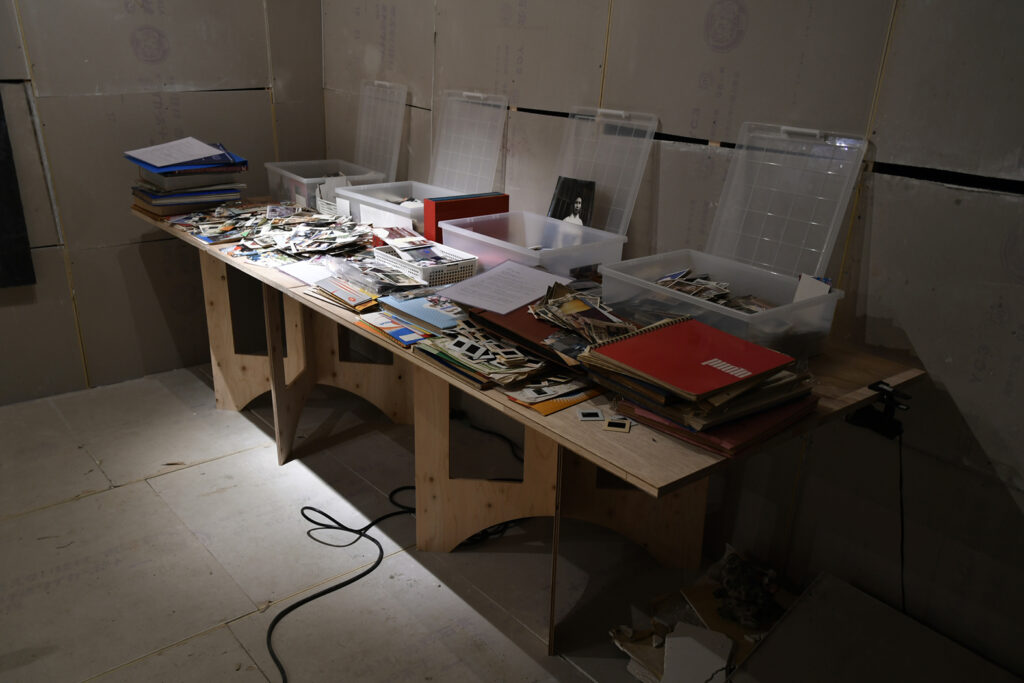
写真が山になるまで
原田裕規
ある時期から、写真のせいで筋肉痛になるようになった。倉庫を兼ねたスタジオとして古いビルの5階の部屋を借りているのだが、そのビルにはエレベーターがないため、何かあるたびに1階と5階のあいだを何度も往復する羽目になる。数年前から写真がぎっしり詰まった箱を抱えてここを行き来することが増えて、そのたびに筋肉痛になった。あまり知られていないと思うが、実は写真はかなり重たい。
写真を回収し始めたきっかけは、不用品回収業者や産廃業者らによって日々回収されているゴミの中におびただしい数の写真が含まれており、引き取り手もなく捨てられているという話を聞いたことだった。その実情を確かめるべく業者を取材してみたところ、現場では「売れる写真」と「売れない写真」が選別されており、前者は蚤の市やインターネットなどの市場に出され、後者はゴミとして捨てられていることがわかった。
気になったのは、取材先で知り合った業者の多くがマイノリティの方々だったということだ。とくに親しくなったのはカメルーン出身のEさんで、プライベートでも連絡を取り合うようになった。Eさんの暮らしぶりを知るにつれ、そうした写真が社会の「周縁」において日々ストックされていることがわかり、それは写真を集めている彼・彼女ら自身の「周縁」的な生き方とも重なって見えた。
こうした写真に共通しているのは、家族写真としても売り物としても何かが決定的に欠けているということだ。現代アートの領域では、持ち主不在の写真の文脈をアーティストが操作して「作品」に仕立てるという話は珍しくない。しかしこれらの写真を見ていると、そうした営みほど白々しいものはないと思う。そう考えるようになったのは、とある業者の倉庫を初めて訪問したときにある光景を目撃したからだった。
業者の運転する軽バンに先導されて辿り着いた倉庫は、外から見るとごく普通の一軒家にしか見えなかった。しかし中に入ってみると、空間のそこかしこに複数の業者がかき集めてきた物が山積みにされている。民家というロケーションも相まって、ほとんどゴミ屋敷にしか見えない。その片隅に、うず高く積まれた写真の山があった。家族の愛情からも資本主義の論理からも見放されてここに積まれることになった写真の山は、社会の全方位に向けて不満を漏らす呪われた記念碑のように見えた。図1〜4は、そうした写真の存在を世にアピールするべく「展示」という形式を借りてそれらの写真を公開した光景である。
それに対して図5〜8は、2020年3月に発売された『広告』Vol.414(特集:著作)に掲載されたアートワークだ。タイトルは《One Million Seeings》。同名の映像作品をベースにしている。24時間かけて引き取り手のない写真を「ただ見る」様子を記録した映像で、そこから52枚の静止画を選び出し、誌面全体に104ページにわたって展開するとともに、前後の見返し用に撮り下ろしの写真[図5-6]を撮影した。この見返しの写真は、業者の倉庫で目撃した光景をイメージして、「誰にも見られていない写真の山」を朝と夜にタイマーで無人撮影したものだ。
僕にとって写真は、忘却したくても忘却できないトラウマのようなものに近い。先ほど、業者の倉庫で写真の山と邂逅したときの印象を「呪われた記念碑」と書いたが、その「何か」は、触れることすら間違っているタブーのようなものだという実感がある。だから本来は、ゴミ同然に打ち捨てられたそれを引き取ることも、光を当てることも「間違っている」のかもしれない。それでもなお、なぜだかそれを無視することができない。ある時期から写真に写った知らない人が夢に登場するようになったが、こうした写真=イメージは、何度打ち捨てられても再帰してくる何かなのだと思う。その存在感を、自らの文脈に引き寄せることなく、むしろ向こうの文脈に引き寄せられるように、危うい体勢を保ちながらも作品として刻印することはできるだろうか?


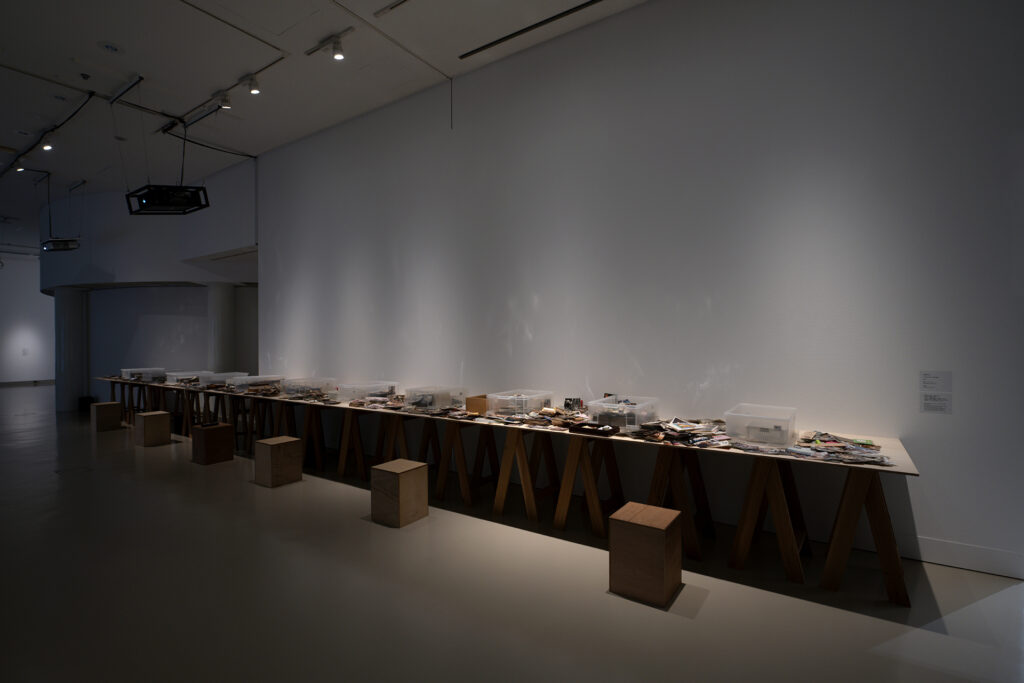
Photo: Katsura Muramatsu
Data download